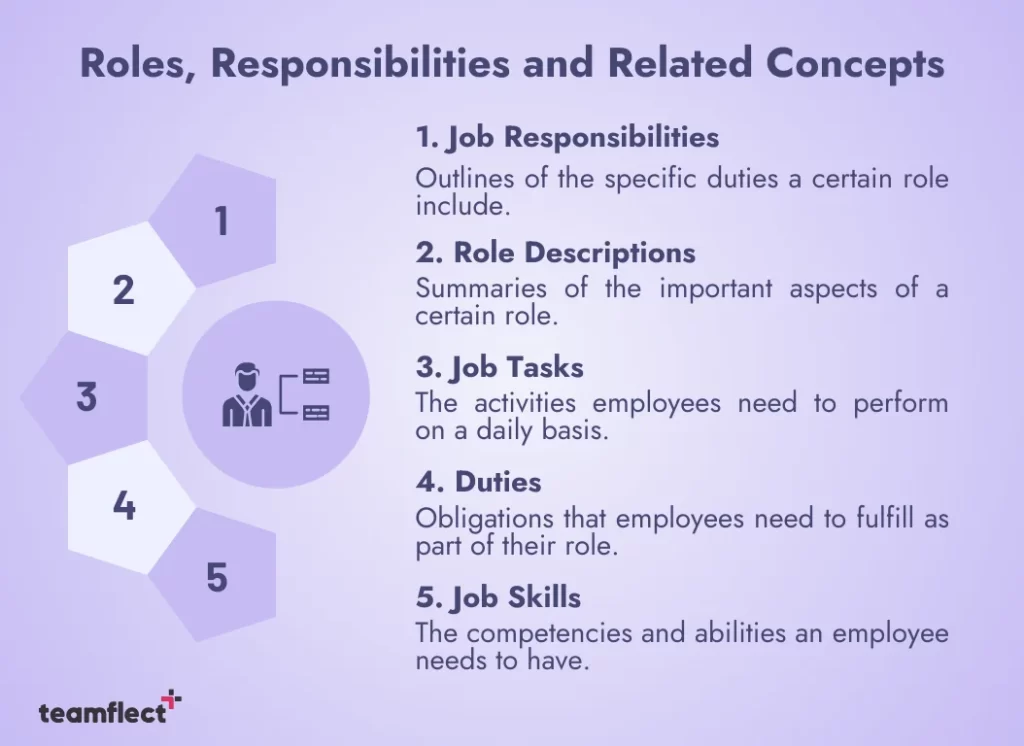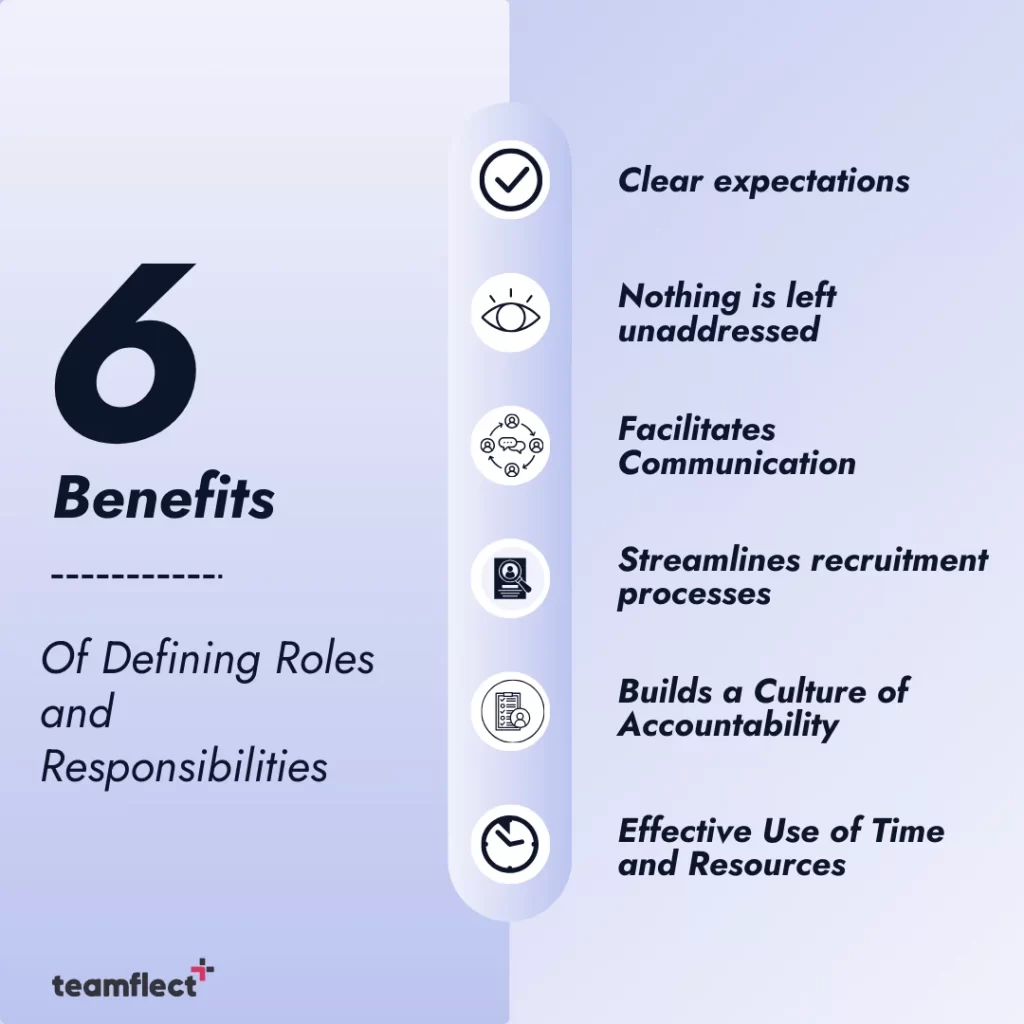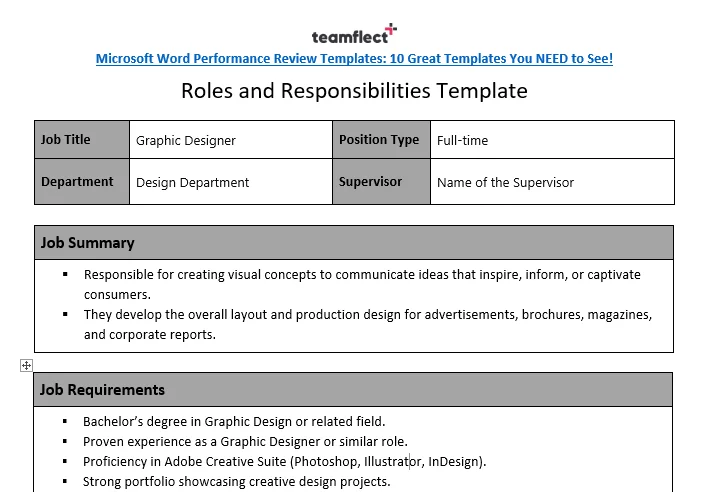Determining roles and responsibilities will drastically improve organizational efficiency by keeping employees on track and creating a harmonious workforce.
In this guide, we are providing you with a roles and responsibilities template to ensure clarity among your employees and create a culture of accountability.
If you are ready to read the most up-to-date and comprehensive guide on roles and responsibilities, let’s get started!
Table of Contents
Definition of Roles, Responsibilities and Related Concepts
“Individual commitment to a group effort: That is what makes a team work, a company work, a society work, a civilization work.”
Vince Lombardi
Let’s explore the fundamentals when it comes to defining responsibilities at work.

1. What Are Job Responsibilities?
Job responsibilities outline the specific duties a certain role includes. The responsibilities that a particular job involves simply demonstrate how employees need to contribute to achieving organizational objectives.
The word ‘responsibility’ originates from the word ‘respondere’ which is Latin and means ‘to vouch’.
What we are saying here is that accepting responsibilities at work means that you are obliged to perform your tasks and achieve your goals.
2. What Are Role Descriptions?
Role descriptions, also referred to as job descriptions, are summaries of the important aspects of a certain role.
The essential information covered by role descriptions includes:
- Title of the job.
- The main purpose of the role is summarized.
- A comprehensive list of duties and responsibilities.
- The skills and qualifications a job entails.
Role descriptions may also indicate the following:
- The reporting structure (who is reporting to whom in an organization).
- Compensation and benefits.
Job descriptions can be extremely useful throughout the hiring process. Moreover, they will act as a foundation for performance reviews once you find the right employee.
3. What Are Job Tasks?
Job tasks simply involve the activities employees need to perform daily which will directly influence the completion of projects and the success of organizational goals.
You can consider them as the building blocks of a certain role.
4. What Are Duties?
Duties refer to the obligations that employees need to fulfill as part of their role. Duties are usually more formal which means that they can involve legal procedures.
Duties are more detailed than responsibilities and less specific than tasks.
5. What are Job Skills?
As a straightforward concept in the context of roles and responsibilities, job skills are the competencies an employee needs to have to complete their tasks and duties.
An employee can acquire job skills through formal education, training, or experience.
To meet performance expectations and climb the career ladders, an employee needs to possess hard and soft skills.
Hard skills can be measured while soft skills can be observed and they are associated with a person’s personality traits.
Examples of hard skills: Programming, data analysis, graphic design, content writing.
Examples of soft skills: Analytical thinking, creativity, work ethic, teamwork.
Benefits of Defining Roles and Responsibilities

1. Employees will know what is expected of them
Defining roles and responsibilities will help employees understand the link between their responsibilities and the bigger team goals.
As a result of knowing the impact of their responsibilities on company or team goals, employees will be more accountable.
2. Nothing is left unaddressed or overlooked
Experiencing issues at work is inevitable but if you clearly define responsibilities, your employees will know who needs to address these problems.
In other words, clarity of roles will increase accountability at work which will in turn help resolve conflicts.
Moreover, outlining responsibilities will help in task management since employees will understand the tasks they need to complete to accomplish team goals.
In short, nothing will fall through the cracks owing to outlining roles and responsibilities.
3. Facilitates Communication
When you understand your colleagues’ roles, you can ask relevant questions to the person who is responsible for doing a certain task.
Team members who know who is responsible for what can ask their questions directly, raise their concerns, or direct their requests to their colleagues.
This will help reduce back-and-forth communication and information will flow smoothly between coworkers.
4. Streamlines recruitment processes
Having a clear outline of roles and responsibilities will help in selecting the right fit for the available seat.
A roles and responsibilities framework can streamline the hiring process for both HR professionals and candidates.
Using a structured framework will allow HR professionals to proceed effortlessly while it will help candidates understand if they possess the required skills and attitudes.
5. Builds a Culture of Accountability
Knowing roles and responsibilities will allow employees to understand what expectations are placed upon them. This will nurture a culture of accountability, effective collaboration, and knowledge sharing.
Ultimately, employees will be more motivated to contribute to the overall success of their company.
6. Effective Use of Time and Resources
You can also ensure effective use of time and resources by defining roles because it can lower time wasted on uncertainty and miscommunication.
Moreover, having a roles and responsibilities framework will allow you to allocate your resources in a way that ensures efficiency and cost-effectiveness.
How To Write Roles and Responsibilities?
Before moving forward to our roles and responsibilities template, let’s demonstrate the key elements of writing roles and responsibilities.
Step 1: Create an Outline
To kick things off, you can determine why you are creating a new role and how that role will contribute to solving the problems or addressing the needs of your company.
You can follow this framework when creating a role description.
- Role Description: Write an overview of the new role’s tasks, functions, and responsibilities.
- Functions/Tasks: Provide a detailed list of the activities the new employee is responsible for.
- Responsibilities: Provide an outline of the expected outcomes linked to the new role.
- Competencies: Write the skills, capabilities, and knowledge necessary to contribute to the success of the organization.
- Experience and Education: Include what kind of experience or knowledge is needed for the new role.
In addition to these, you also need to clarify whether employees will work remotely, in a hybrid way, or from an office setting.
Step 2: Establish Clear Agreements for Collaboration
Establishing agreements for effective collaboration will allow team members to work together in harmony.
You need to define how a single employee will contribute to the mission of their team with their skills and knowledge.
Your Free Roles and Responsibilities Template!
A great roles and responsibilities template is clear, concise, and customizable to meet the specific requirements of your company.
Our well-designed roles and responsibilities template highlights what is expected from the role and what qualifications are necessary to ensure success.
However, you need to regularly review this roles and responsibilities template to reflect any changes in the role or your company.
Our roles and responsibilities template offers a solid and straightforward framework as it includes sections that summarize the job, its requirements, and responsibilities.
Let’s explore what each of these sections that our roles and responsibilities template includes:
- Job Summary: This section of our job responsibilities template provides a brief overview of the role, and summarizes its main purpose and goals.
- Responsibilities: This section of our template lists the main tasks and duties that the role entails. It describes the responsibilities in detail including specific actions or activities required to be successful in this role.
- Job Requirements: In this section of the roles and responsibilities template, the key skills, qualifications, and experiences of a graphic designer are listed.

Examples of Job Descriptions, Roles and Responsibilities
To help you craft your own roles and responsibilities template, we are also providing you with example roles and responsibilities.
You can create your own roles and responsibilities template by examining the following job descriptions below.
Example 1: Marketing Manager
Job Summary: The main responsibilities of marketing managers are overseeing campaigns to build brand awareness, generate leads, increase conversions, and simply do all marketing activities.
Furthermore, marketing managers lead their teams and ensure collaboration with other departments to execute marketing strategies in alignment with organizational goals.
Being a marketing manager entails creativity, strategic thinking, and analytical skills to assess the performance of marketing efforts.
Responsibilities:
- Crafting and implementing marketing strategies.
- Managing the marketing team by setting goals, providing support and guidance, and measuring performance.
- Overseeing the marketing products such as advertisements, and other digital content.
- Management of all digital marketing efforts like social media, email marketing, and website content.
- Effective collaboration with sales and product teams to merge interdepartmental efforts.
- Monitoring and analyzing metrics to gauge how effective campaigns are and facilitate decision-making.
- Research to understand the trends, opportunities, and consumer behavior.
- Effective management of marketing budgets.
Job Requirements:
- Bachelor’s degree in marketing, business, or related field.
- At least 5 years of experience in marketing with a minimum of 2 years in a managerial role.
- Demonstrated success in developing and executing marketing strategies.
- Excellent leadership, communication, and interpersonal skills.
- Proficiency in marketing analytics tools and CRM software.
Example 2: Project Manager
Job Summary: Project managers plan, execute, and close projects in budget and scope. They are responsible for leading different teams, ensuring management of resources, and communicating project status.
Must-haves for this role are strong organizational and problem-solving skills as well as attention to detail and effective risk management.
Responsibilities:
- Determining project goals, scope, and deliverables by working together with stakeholders.
- Crafting elaborate project plans, schedules, and budgets for the timely execution of projects.
- Assigning responsibilities and tasks to their direct reports and tracking the progression.
- Managing the resources and making sure that everyone adheres to the project budget, schedule, and quality standards.
- Identifying and addressing project risks head-on and communicating the status and changes of projects to stakeholders.
- Assessment of project performance and building a strategy to address areas for improvement.
- Moderating project meetings and keeping the documents of projects.
Job Requirements:
- Bachelor’s degree in project management, business, or related field.
- Minimum 3 years of experience in project management.
- Excellent leadership, communication, and negotiation skills.
- Proficiency in project management tools and methodologies such as Agile or Scrum.
- Certification in project management (PMP, PRINCE2, etc.) is preferred.
Example 3: HR Manager
Job Summary: HR managers are responsible for overseeing all HR-related activities that will contribute to the creation and implementation of new HR strategies.
HR managers supervise HR professionals and guide them throughout the hiring, performance management, talent development, and employee engagement processes.
Being an HR manager entails strong social and leadership skills as well as a solid grasp of employment laws.
Responsibilities:
- Creating and implementing HR initiatives and strategies that align with organizational goals.
- Handling the hiring and onboarding processes in a way that ensures a positive experience for candidates.
- Management of employee relations through effective conflict resolution and applying disciplinary measures.
- Creating HR policies and procedures according to employment laws and regulations.
- Managing performance through effective goal-setting, reviews, and development plans.
- Guiding and supporting everyone regarding HR-related inititiaves and issues.
- Executing employee benefits programs that include health insurance, retirement, and employee well-being.
- Implementation of employee development plans to improve skills and performance throughout the organization.
- Managing HR-related analytics to gauge the effectiveness of the activities in the HR department.
Job Requirements:
- Bachelor’s degree in Human Resources, Business Administration, or related field.
- Minimum of 5 years of experience in HR management roles.
- Demonstrated knowledge of HR best practices, employment laws, and regulations.
- Excellent leadership, communication, and interpersonal skills.
- Proficiency in HRIS software and Microsoft Office Suite.
- HR certification such as SHRM-CP or PHR is preferred.
Flexible Job Descriptions
Traditional job descriptions may not be applicable considering the fast-evolving marketplace demands.
According to an article in Harvard Business Review, writing flexible job descriptions can help companies find talented employees by writing the fundamental expectations of the position.
You can write flexible job descriptions by applying the following three approaches.
Outcome-focused Descriptions
Outcome-focused descriptions will highlight the main outcomes that hire is expected to deliver. These descriptions don’t include the tasks and duties of the new employee.
Using this approach offers flexibility to come up with the most effective ways to achieve those outcomes.
Skills-focused Descriptions
These descriptions focus on the skills and competencies an employee needs to possess. This approach includes a shift from tasks to talents and how employees can use their skills within the context of a certain role.
Team-based Descriptions
This approach focuses on ensuring collective contributions by highlighting team responsibilities, goals, and deliverables.
How to Define Roles and Responsibilities Easily by Leveraging Teamflect’s AI Feature
It’s the perfect time to leverage AI to streamline your HR processes since AI can take care of the tedious tasks for you while allowing you to handle more important responsibilities effectively.
To facilitate your HR processes, Teamflect continuously develops AI performance management features for Microsoft Teams users.
Teamflects cutting-edge AI capabilities will help you:
- Save time and boost productivity.
- Scan your org chart, create job descriptions, identify core competencies and responsibilities in a snap.
- Map out individual career paths and set goals for them that match their aspirations and talents.
Defining roles and responsibilities for employees will be a breeze with Teamflect which ensures strategic talent development in an effective and fun way.



